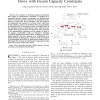Free Online Productivity Tools
i2Speak
i2Symbol
i2OCR
iTex2Img
iWeb2Print
iWeb2Shot
i2Type
iPdf2Split
iPdf2Merge
i2Bopomofo
i2Arabic
i2Style
i2Image
i2PDF
iLatex2Rtf
Sci2ools
TSP
2010
2010
Distributed detection of multi-hop information flows with fusion capacity constraints
The problem of detecting multi-hop information flows subject to communication constraints is considered. In a distributed detection scheme, eavesdroppers are deployed near nodes in a network, each able to measure the transmission timestamps of a single node. The eavesdroppers must then compress the information and transmit it to a fusion center, which then decides whether a sequence of monitored nodes are transmitting an information flow. A performance measure is defined based on the maximum fraction of chaff packets under which flows are still detectable. The performance of a detector becomes a function of the communication constraints and the number of nodes in the sequence. Achievability results are obtained by designing a practical distributed detection scheme, including a new flow finding algorithm that has vanishing error probabilities for a limited fraction of chaff packets. Converse results are obtained by characterizing the fraction of chaff packets sufficient for an informati...
Artificial Intelligence | Chaff Packets | Communication Constraints | Distributed Detection Scheme | TSP 2010 |
| Added | 22 May 2011 |
| Updated | 22 May 2011 |
| Type | Journal |
| Year | 2010 |
| Where | TSP |
| Authors | Ameya Agaskar, Ting He, Lang Tong |
Comments (0)

